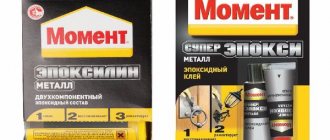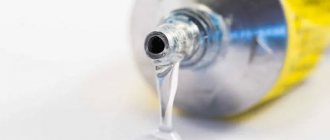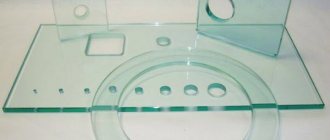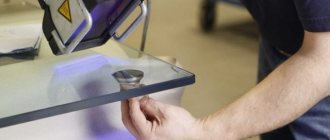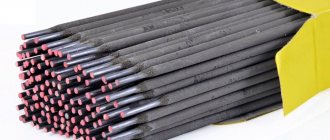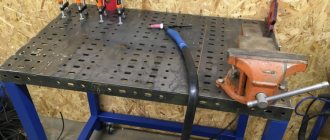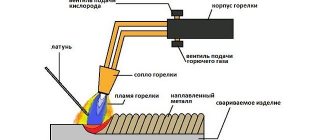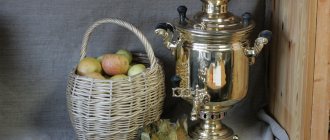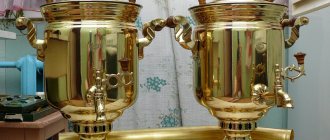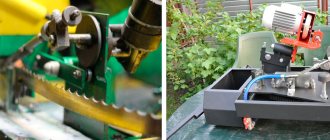What kind of glue should it be?
For a neat, durable seam, it is better to glue glass to metal with a transparent compound. This is the only way the result will be almost invisible.
The composition should also be:
- durable (with a high degree of adhesion);
- with a sealed and moisture-resistant result (for example, for installing auto glass, restoring aquariums);
- fast-hardening.
Store-bought adhesive can be replaced with a mixture prepared by yourself. This is possible when the color of the seam is not important. To glue glass and metal at home you need to take:
- gypsum (2.5 parts);
- lead litharge (2.5 parts);
- chalk (2.5 parts);
- rosin (3.5 parts).
The mixture is thoroughly mixed and diluted with drying oil. The consistency of the result should resemble putty. This glue can be used to connect metal to rubber and glass surfaces.
Home Remedies
You can get out of a difficult situation when you need to glue glass products together not only by using store-bought products. Some home craftsmen use homemade adhesive mixtures.
- To prepare the simplest remedy, you will need bone glue and ash. Mix the ingredients well. Before applying the composition, be sure to warm up the glass.
- You can also prepare a mixture of casein and silicate glue. These substances are taken in a ratio of 1:10.
- If you need to fix a small piece of light glass, then ordinary garlic juice can help you with this.
- You can glue glass products to wooden ones using a composition prepared on the basis of wood ash and wood glue.
- Sometimes in everyday life there is a need to glue a window frame, an aquarium or a large vase. For this you can use the following tool. Take 100 g of rosin, 50 g of drying oil, 50 g of chalk powder and 10 g of beeswax. Mix all ingredients, bring to a boil, cool to +50 degrees, and then add 25 g of cement.
Surface preparation
Regardless of what composition you choose for gluing, you need to prepare the glass product for repair.
How to glue metal to glass
The reliability of gluing depends on the conditions of use of the item. If a moisture-resistant sealant is needed for aquariums and exterior work, then it is better to carry out internal repairs with a non-toxic composition.
Some adhesives cannot withstand temperature changes or do not provide elasticity to the hardened seam. Transparent mixtures are suitable for decorative and outdoor works. For parts subject to loads and vibrations, the seams must be elastic.
Cyanoacrylate
This is ordinary superglue, sold in all hardware stores. Sets in 5 seconds. Easy to use. Suitable for surfaces protected from moisture, as water can destroy the seam.
To glue the surfaces, you need to lubricate them and press them tightly together for 5-10 seconds.
It is better to use a two-component composition in your work. It is waterproof and dries quickly. Even before mixing the glue, you need to prepare the surfaces (degrease and clean).
Superglue Cosmo CA-500.200
Sealant
The sealant is suitable for durable connection of parts under possible sudden temperature changes. It is used when moisture resistance is more important than the degree of rupture and the permissible mechanical load on the seam. Surfaces must be cleaned and degreased in advance. You need to squeeze the parts tightly for at least 10-15 seconds. You can use the part/item the next day.
- The relatively expensive WEICON Black Seal is black in color. It is suitable for interior work and successfully withstands excessive heating of surfaces (up to +300 °C). For example, when repairing a glass door in an oven.
- Soudal Gasket Seal is red in color. The product can withstand heating up to +285 °C and serves as a reliable gasket between connected surfaces.
- When using WEICON Silicone F (not exceeding +185 °C), you can count on resistance to precipitation. Suitable for items exposed to moisture and vibration. Hardens within 3-5 hours. Superglue is inferior in terms of adhesion. Heat-resistant sealants are not “afraid” of fat and oils, treatment with household chemicals, as well as negative air temperatures.
Moment Crystal
The composition is suitable if an elastic (elastic) seam is needed. When pressure is applied to such a connection, temporary deformation should be observed (with subsequent restoration of shape). The glue is transparent, which means it does not leave marks and does not stain the surface. Moment Crystal can be used to glue glass, porcelain, ceramics, as well as cork, wood, and PVC. Excess drops easily roll into a ball and are removed from the surface (only after drying). Not suitable for dishes. The glue is immediately ready for use after purchase.
Automotive glue
The frozen seam remains resistant to aggressive environments and moisture. Not suitable for outdoor use due to black color. Most often used in auto repair shops. The composition is more like rubber. It is recommended to warm up the surfaces thoroughly immediately before joining. The application of glue should be gradual.
- Cleaning surfaces from dirt, dust and foreign objects.
- Degreasing the parts to be joined (provided that the product does not form a protective film).
- Checking the tightness of the parts connecting to each other.
- Warming up the surfaces with a construction hairdryer to a temperature of +30 °C.
- When fixing parts, the seam should be horizontal.
Gluing surfaces must be done while they are still warm. The layer should be as uniform as possible, and excess should be removed immediately.
Automotive adhesive is the best choice for windshield repairs.
When working in a cool room, there is a risk that over time the seam will lose its tightness and integrity.
Two-component adhesive
Can be used in work where heat resistance of the seam is not required. The epoxy-based adhesive is waterproof and protects against current (dielectric). The connected parts must be fixed for 3-5 hours.
You can speed up the drying of the seam only by gradually heating it with a hair dryer.
- The two-component Poxipol adhesive is considered the best. They fasten metal, glass, and fragments. Suitable for substrates in contact with water (aquariums).
- UHU Plus Schnellfest adhesive is more suitable for working with small particles. Odorless, transparent. Suitable for modeling (in needlework).
Poxipol
UV glue
This is a heat-resistant adhesive with maximum seam strength. One-component and easy to use in everyday life. The disadvantage is the presence of a strong unpleasant odor. To ensure maximum strength, the seam is exposed to ultraviolet rays.
- Verifix MV 760. The seam is moisture resistant and does not change color over time (does not turn yellow). Used for fastening parts subject to mechanical loads.
- The peculiarity of the Verifix LV740VIS composition is due to the plasticization of the composition under the influence of the sun or artificial ultraviolet radiation. The result remains elastic and extremely durable at the same time.
- Ultraviolet adhesive B 665-O is suitable for work where a neat, inconspicuous seam is important. The composition has deep penetration, but after drying it becomes brittle (not elastic enough).
Types of transparent glue
To glue glass parts to metal, you can use:
- high-temperature silicone compounds (sealants) that dry in 12-24 hours;
- silicate mixtures (liquid glass) that are resistant to water and elevated air temperatures;
- polyurethanes (with the addition of plasticizers), suitable for repairing cars and household appliances.
Sealants are suitable for surfaces exposed to high temperatures, such as glass oven doors. The advantage of the sealant is its resistance to contact with fat and oils. The repaired item can be used at temperatures ranging from -60 °C to +300 °C.
Sealant remains the best choice for aquarium restoration.
Among the most popular ones, the red Soudal Gasket Seal composition stands out, which serves as a reliable gasket between the parts. And WEICON Silicone F sealant is used to obtain a reliable transparent seam. The latter can withstand heating up to +185 °C, but is not “afraid” of the influence of atmospheric factors. A sealed seam takes longer to dry and is inferior to other adhesives in terms of adhesion.
Let's move on to the attachment
Now is the time to get down to business. To do this you will have to follow this algorithm of actions:
- Make a hole at the ends of each leg.
- Attach suction cups to these holes using very strong glue.
- When the adhesive has dried, use a felt-tip pen to mark the locations of the furniture legs on the tabletop.
- Degrease the marked areas using acetone or gasoline.
- Glue the glass tabletop to the legs of the table and wait for it to fully set.
- Irradiate until the adhesive completely polymerizes.
The glass top for the kitchen table is glued!
How to glue
- Even before starting repair or restoration work, it is important to prepare clean rags, detergents and degreasers.
- If UV glue is to be used, a UV lamp is checked.
- You will need a vice or a special press to fix the connected parts.
Preparing the base
To ensure high adhesion, absolutely clean surfaces without dust, grease and rust are needed.
If the metal is without decorative coatings, then it can be treated with white spirit or acetone (wipe with a rag soaked in solvent). Vodka or medical alcohol from a pharmacy is suitable as a solvent. If cleaning glass from greasy stains is carried out with a soap solution, then it is thoroughly washed off. The glass itself is additionally wiped with alcohol.
Painted parts are pre-treated with sandpaper. Before applying the adhesive layer, all parts are dried and wiped with a dry cloth.
Gluing
- The prepared glue is applied to both surfaces and spread to a minimum thickness.
- The edges of the joints must be processed.
- The parts are tightly folded together and compressed with maximum force.
- The interlocked bases are carefully placed in a vice or placed under a press so that the seam is horizontal.
- Excess drops of glue are removed immediately with a clean rag.
- The impact of the press should not be heavy, so as not to break the base of the objects.
Increased strength of the seam is achieved by additional heating (up to +30 °C – +40 °C).
A sharp change in temperature can cause cracks in the glass, so heating with an open fire is unacceptable.
Using a hairdryer will warm the surface and also remove unnoticeable condensation.
Using UV Lamp
A special UV glue is used. It contains urethane resin or methacrylate ester. The product is heat-resistant, transparent and does not transmit light. It has a strong unpleasant odor. Exposure to ultraviolet light can increase the strength of surface joints. Before this, the parts must be warmed up (up to +60 °C).
A thin, even layer of glue is applied, and then everything is connected and fixed. Irradiation with an ultraviolet lamp is carried out twice. The first time you can increase the reliability of the result to 70%, and after the second treatment - up to 100%.
The duration of irradiation depends on the power of the lamp itself. At the first stage, the process should last 10-120 seconds, and repeated processing should last 1-5 minutes. The finished joint will not only be strong, but will also tightly hold the parts together (it cannot be torn).
It is better to wear protective glasses when working with ultraviolet lamps. If drops of glue will be invisible on ordinary glass, then on matte surfaces the excess must be removed immediately.
Brief summary
There are many adhesive compositions; when making a purchase, you should carefully read the description of the product, and sometimes consult the seller, specifying the purpose of using the solution. As has already become clear, transparent specimens are very popular, the seam is invisible and will not spoil the interior of the home, the mixture is suitable for implementing decorative processes.
At the time of work, it is better not to deviate from the sequence specified in the instructions; only professionals use this algorithm of actions. Therefore, the technology of conventional fixation and the use of a UV lamp is considered effective; over the course of several years, specialists have achieved extremely positive results. By refusing to comply with at least one of the generally accepted rules, a person risks creating a connection of poor quality, which over time will simply disappoint the owner of the building.
Adhesive for glass and metal - types, properties, instructions for use
Products made of metal, alloys and glass are often found in everyday life and interior design. Metal and glass surfaces sometimes have to be glued together, for example, when repairing household appliances.
Conventional glue may not be suitable for this purpose, because in order to bond dissimilar materials, the adhesion of the composition must be maximum.
Glue for glass and metal must be strong, reliable, and high quality, then the joint will not cause any complaints.
Usually, a transparent glue is selected for gluing metal to glass, because it will provide the most aesthetic seam, which will be practically invisible from the outside. This quality of glue is especially important if you plan to glue glass decor to a metal base. But the absence of color and invisibility are not the only requirements for the material. The best glue also has the following properties:
- Strength. If the product will withstand high loads, you should buy glue only with increased adhesion, for example, compounds that become even stronger under the influence of UV irradiation and glue the parts almost forever.
- Tightness and moisture resistance. Some products act as a sealant. They are indispensable for gluing glass to metal if the joint will be exposed to moisture. Most often, sealants are used when inserting car glass and gluing an aquarium on its own. There are even black sealants that make the future product stylish, with expressive contours.
- Hardening speed. Some products dry in just a few seconds, others polymerize over a long period of time under the influence of ultraviolet light.
If the transparency of the composition is not critical, you can use homemade glue. Its components are as follows: 2.5 parts each of gypsum, lead litharge, chalk, 3.5 parts rosin.
This mass is diluted with drying oil to obtain a mixture with the consistency of putty. It will firmly adhere to metal and glass, as well as rubber and metal.
Among purchased adhesives, there are different products that have different compositions and properties.
Moment-Crystal
This product is absolutely transparent and leaves no traces. It is ideal for colored materials and has minimal evaporation time.
“Moment-Crystal” can glue not only metal and glass, but also porcelain, ceramics, cork, wood, plexiglass, PVC in various combinations. If there is excess adhesive left on the surface, no solvent will be required.
You need to wait for the product to dry, then carefully roll it into a small ball and put it away. The downside is the unsuitability of “Moment” for products in contact with food.
“Moment-Crystal” is suitable for substrates subject to load, because the adhesive seam will be quite elastic. After the impact ceases, the layer returns to its original state without deformation. The glue is one-component, it is convenient to use, since there is no need to dilute or mix the components with each other.
How to glue correctly - technology
To work, you will need the glue itself, carefully prepared parts, means for degreasing and washing them, and rags. A UV lamp may be needed to heat the surface and irradiate it, and a press or vice may be needed to fix the parts.
Useful tips
Despite the fact that glass gluing seems complicated, it can be done quite quickly and without difficulty. To do this, just follow the instructions from the manufacturer and take care of your own safety.
It is recommended to purchase products for gluing glass exclusively in specialized stores in Moscow, which can provide the correct storage conditions for the goods. Expired transparent glass adhesive should not be used. The properties of compounds with an expired shelf life are lost.
To clearly understand the features of transparent glass adhesive, we recommend watching the thematic video:
Leafing through the catalogs
If you carefully examine the contents of the thick catalogs of leading suppliers of furniture fittings, you will find that there are no more than ten out of a thousand pages devoted to fittings for furniture made entirely of glass. We can say that there are almost no fittings for glass furniture; rather, it is produced only for products using glass.
The first to appear (back in the 60s of the last century) were plastic runners with a W-shaped cross-section, installed in a body made of chipboard. They moved sliding doors made of a single sheet of glass that did not have any frame. It is curious that in the domestic furniture industry, drilling holes for the handle due to the lack of appropriate equipment at furniture factories, as a rule, was not carried out, and during its manufacture a vertical groove was made in the sheet, by which it was moved along the guides. Plastic corner connectors have become widespread for creating glass display cabinets in retail establishments.
Today, the design of glass door sliding mechanisms has become significantly more complicated: W-shaped guides have been abandoned almost completely. For example, hollow corners are placed on all corners of a rectangular sheet of glass that does not have any cutouts or drillings and secured with screws. Of these, the lower ones each have one roller with a groove that rolls along a guide, and the upper ones each have two smaller diameters, which move in the groove of the U-shaped upper guide. With double glass in the product, the depth of this design does not exceed 40 mm. There are also mechanisms for sliding glass doors with guides in the form of metal rolling pins, placed outside the body and having additional decorative value.
Glass fasteners
Fittings for glass are different from those used for other materials; The reason is the glass itself, which not only has an exceptionally smooth surface, but is also fragile and transparent.
Therefore, if you need to clamp it with screws, drill or stick something on it, you need to act very carefully. After all, one chip can damage the entire glass surface. It is extremely undesirable to expose glass to damage and impact, which is why they use fittings that can protect the surface from impact and point loads. In the 20s of the last century, constructivist designers tried to use glass in home interiors, since then glass furniture has gained the right to life. However, there are very serious obstacles to its widespread dissemination. The main one is the impossibility of cutting out a product from a single glass monolith with an ax or chisel. Therefore, it is used mainly in the form of sheet elements, which are connected using special fastening devices.
Serious restrictions
Glass furniture has a very distinctive appearance, often creates a feeling of cold and does not fit into every interior. However, glass often becomes the most important element of the design, providing an overview of the contents of the cabinet or even transparency of the product. Another problem is the fragility of glass. Once upon a time, every city house had a janitor with a broom, and children played football in the courtyards, whose main fear was to hit someone’s window with the ball. Those times are forgotten, but the sound of broken glass is familiar to everyone. That is why, when anyone sees glass furniture, the thought arises that it can easily break, and its fragments are simply dangerous.
The need to connect blanks cut from glass to each other, in turn, led to the use of fittings similar to those used in furniture made from panel parts made of wood and wood materials. Glass can be drilled, shaped cuts can be made in it, but a screw cannot be driven into it, threads cannot be cut into holes in glass, blind grooves cannot be milled in it, etc. But tempered glass cannot be processed at all: it immediately breaks into fragments, so all impacts must be carried out before it is tempered.
Unlike many materials, glass parts adhere well to each other to form a strong connection. But the surface of the metal part glued to the glass must not only be smooth, but also processed with high quality, and the elements themselves must have an aesthetic appearance, which is unattainable, for example, when using various types of screeds. Fittings used in glass products must be particularly decorative due to the transparency of this material.
To create exclusive designs, in addition to standard chrome, gold and polished stainless steel, they often use fittings finished with an aging effect in bronze, brass and copper in a matte or glossy finish.
Basic methods of fixing glass
- 1. Gluing with double-sided tape.
- 2. Gluing with ultraviolet glue.
- 3. Thermal bonding method.
- 4. Fastening using fittings, which include: clamping profiles, brackets, point connectors, hinges, shelf holders, etc.
- 5. “Embedding” into a wall panel using special solutions. This operation is carried out at the stage of finishing work.
The last method belongs to the category of “jewelry”. Since performing such work requires high precision and accuracy from the performer, since the glass module can easily be stained with the solution during the plastering process. This technique is applicable in cases where you need to decorate a wall with mirrors or glass elements. If the decorating area is small, then professional glue can easily cope with this task.
Loops
In sliding wardrobes, it is sometimes undesirable to reduce the depth of the cabinet due to the use of large-format sliding systems. Quite a few designs of rotary (hinge) hinges have been developed for such frameless glass doors. Regardless of the design of the hinge mechanism itself, they primarily differ in the methods of attaching glass to them. There are hinges in which the glass is inserted into the gap between two plates of the body and secured with screws through an elastic gasket, and hinges that are secured in a hole or shaped groove selected in the glass. In the second case, the hinge body is secured on the front side with a nut covered with a decorative cover. This method almost completely eliminates the displacement and loss of glass during operation, but forces you to purchase quite expensive equipment for drilling glass or processing grooves in it. In addition, any holes, and especially grooves, are stress concentrators and weaken the glass. Tempered glass cannot be processed, and only a few can afford to temper it after all other influences in a furniture factory.
Shelving and cabinets
The design of glass shelves and cabinets for television and radio equipment is based on the same principle. Threaded rods are passed through through holes drilled in the shelves, onto both ends of which nuts with blind threaded holes are screwed, the outer visible surface of which has a decorative treatment. The gaps between the shelves are filled with pieces of pipes of round, square or other cross-section, made of metal or plastic (with metallization or imitation of wood texture pattern). The lower ends of the pipes are equipped with stationary or roller supports. There are tubular profiles with a square cross-section that have grooves on one or two adjacent side surfaces into which sheets of glass or other material can be inserted. Let us remind you that if there are doors, a rack or cabinet turns into a cabinet product, closed on all sides.
Accessories
Interesting solutions in the development of components for furniture using glass. For example, there are mechanisms for extending tables, in which the tabletop is made up of individual glass plates, which are moved inside the table like blinds. The cabinets use rather complex mechanisms that specifically provide for the presence of narrow glass plates in the curtain doors that open in the vertical direction.
Furniture made entirely of glass is unlikely to ever be included in the list of essential goods - at least because of the established opinion about its fragility. In addition, cabinet furniture made of transparent glass, intended primarily for use as storage, like a display case, does not protect its contents from prying eyes, which makes it necessary to maintain ideal order inside and limit its contents, which is not always convenient. Therefore, preference will always be given to combined furniture, in which glass plays a mainly decorative role. Therefore, to use this amazing transparent material, more and more special fittings will be required.

